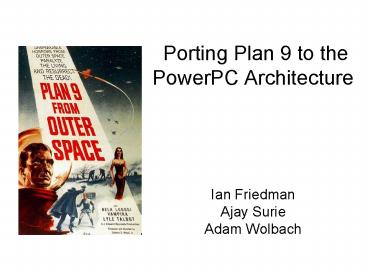Porting Plan 9 to the PowerPC Architecture PowerPoint PPT Presentation
1 / 14
Title: Porting Plan 9 to the PowerPC Architecture
1
Porting Plan 9 to the PowerPC Architecture
- Ian Friedman
- Ajay Surie
- Adam Wolbach
2
Plan 9http//www.cs.bell-labs.com/plan9dist/
- OS developed by Bell Labs in order to
cost-effectively manage large, centralized
resources to employees at cheap, less powerful
terminals - Key Features
- Centralized resources allow for efficient
management/sharing - Local name space, regardless of the box in front
of you - Everything is (theoretically) considered a file,
including devices - Thus, there exists a unique protocol that
accesses everything - Cheap for large-scale implementations
3
Project Additions
- What We Wont Change
- Fundamental operating system design
- Specification of OS remains the same, no new
features - What We Will Add
- Compatibility with 32-bit PowerPC architectures
- Booting with OpenFirmware and BootX/Yaboot
- Memory Management
- Device Support Console I/O, Ethernet
- This is the type of PowerPC downstairs 74xx
(almost certain of this) - Compatibility with 64-bit PowerPC architectures
with 32-bit emulation
4
Resources
- 412 Lab/Wean Hall 3508 Cluster
- 1 iMac G4
- 744x Series PowerPC
- Used for Testing
- 3 Linux Boxes
- Made of miscellaneous parts off the CS pile
- Reasonably fast
- Used for Coding/Compiling/Debugging
- Everything we need has been provided
5
Code Base
- Plan 9 existing PowerPC code
- C Code 10,000 lines
- A lot of it is code for different PPC hardware (2
ethernet drivers, Saturn, 8260) - Can use Plan 9 common kernel routines (i.e.
main.c) and kernel interface to ethernet (1000
lines) - Probably dont need to touch protocol code TLS
1.0, SSL 3.0 (2000 lines) - Can completely ignore flash related code (BLAST)
and UART serial code (2000 lines) - Plan 9 assembly code 1100 lines
- Not sure how much will need to change
6
Booting Plan 9
- OpenFirmware
- Uses Forth as its command interface
- Provides basic hardware support
- Loads the kernel for us
- Can load kernel over TFTP!
- Once the kernel is loaded, we still need to talk
to OF for devices
7
Booting Plan 9 (contd)
- The Task at Hand Figure out how to talk to OF
for device support (console/ethernet) - Investigating two possibilities
- Primary BootX
- Darwins bootloader
- Not very well documented
- Secondary/Backup Yaboot
- Used by PPC linux distributions
- Also not very well documented
8
Memory Management(based on http//users.rowan.edu
/shreek/fall01/comparch2/lectures/PowerPC.ppt)
- Using PowerPC 740/750 architecture specification
(32-bit) - 2 Memory Management Units
- Distinctive behaviors for Data and Instruction
fetches/translations - Each have their own L1 cache
- Unified L2 cache
- Memory Support
- Physical Memory 64 Gigabytes (236)
- Virtual Memory 4 Pentabytes (252)
9
Memory Address Translation
- 3 Address Translation Modes
- Page Address Translation
- In other words, virtualization via segmentation
- Translation from 32-bit effective address (EA),
to 52-bit virtual address (VA) (by segment
table), to 32-bit real/physical address (PA) (by
page table) - Segment table comprised of 16 on-chip segment
registers - Segmentation also used as memory-mapping for I/O
devices - Block Address Translation
- EA translated to PA via BAT table lookup
- Table is actually set of pairs of on-chip
registers (limiting the number of possible
Blocks), separate for Data and Instructions - Real Addressing Mode
- Effective Address Physical Address (i.e., no
virtualization)
10
(No Transcript)
11
Memory Management
- Documentation
- Actual specification
- http//www-3.ibm.com/chips/techlib/techlib.nsf/te
chdocs/ 852569B20050FF7785256996006C28E2/file/7xx
_um.pdf - Google PowerPC 740 750 RISC Microprocessor
- IBM Overview
- http//www-306.ibm.com/chips/techlib/techlib.nsf/
techdocs/ - FBEAAB9F7A288ED787256AE200622214/file/PowerPC750
FXmpf.pdf - Googlepowerpc 740/750 memory management unit
- Brief introduction to PPC architecture
http//users.rowan.edu/shreek/fall01/comparch2/le
ctures/PowerPC.ppt
12
Lines of Code to Write
- Bootloader
- Existing open source code available, may require
minor modification - Memory Management (300 lines)
- Interrupts / Hardware specific (350 lines)
- Device Drivers
- Console (200 lines depending on available code
for PPC) - Ethernet (800 lines)
- Clock / Timer (100 lines)
- Total gt 1800 lines
13
Brief Schedule - Optimistic
- 14 weeks remaining in the semester
- Stage I (2 3 weeks)
- Understand existing code / architecture
- Stage II (4 weeks)
- Open Firmware / Booting (4 weeks)
- Memory Management (4 6 weeks)
- Stage III (3 weeks)
- Console driver
- Ethernet driver
- Integration
- Stage IV (2 weeks)
- Debugging / making it work
14
Issues / Challenges
- Understanding existing code base
- Poorly documented, module structure unclear (not
the way we were taught in 410!) - Will probably require more time than we expect
- Understanding Plan 9 assembly
- Integrating new code maintaining the Plan 9
way of kernel implementation - Probably others we havent thought of

